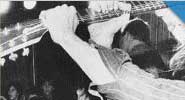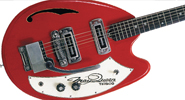 Of all the cool ’80s alternative rock bands, the loveable ramshackle jag-offs in the Replacements were the least likely to give a toss about, oh, anything much at all. That attitude permeated everything about the Minneapolis quartet, and it was always a big reason for the band’s appeal. It was also intrinsic to a creative process responsible for some of the most enduringly smart-yetstoopid pop rock of the last
Of all the cool ’80s alternative rock bands, the loveable ramshackle jag-offs in the Replacements were the least likely to give a toss about, oh, anything much at all. That attitude permeated everything about the Minneapolis quartet, and it was always a big reason for the band’s appeal. It was also intrinsic to a creative process responsible for some of the most enduringly smart-yetstoopid pop rock of the last
30 years.
Think about it: This really wasn’t a band you imagined collecting its own memorabilia. Hell, you got the feeling the members could barely collect enough cash for the month’s rent. (I dunno, maybe Paul Westerberg has a issues old issues of Spin stuffed in a drawer somewhere.)
So if this new photo history were a Replacements album, they’d probably have titled it “Someone really saved all this crap?” But thankfully some fans did, and they’ve managed to cull everything together for this very worthy photo history that will have you chuggin’ brews and cranking classics such as “I Will Dare” and “Bastards Of Young” until ungodly hours of the night.
Waxed-Up Hair and Painted Shoes is a gold mine of Replacements ephemera, made all the more special by the fact that a majority of the stuff included here was produced in those halcyon days of the early 1980s, that pre-internet world when everything in alternative music was basically done by word of mouth, word of zine, and word of flier.
Fliers, in particular, played an important part in the life of the bands of the ’80s such as the Mats, and there are some great ones in this collection. Also special are the numerous live photos, most unseen by any fans and rounded up by co-author (and VG gear editor) Dennis Pernu. If you always heard about original guitarist Bob Stinson’s penchant for wearing tutus and dresses at shows, but never got to experience it live, well, there are plenty of pictures here to satisfy your sartorial curiosity.
Overall, it’s big fun to take a spin down memory lane with these boys. The band has aged well, particularly its songs, and the recent spat of attention cast its way is certainly warranted and welcome.
To sum up Waxed-Up Hair and Painted Shoes, one of the Replacements’ song titles comes to mind: Color me impressed.
This article originally appeared in VG‘s March ’14 issue. All copyrights are by the author and Vintage Guitar magazine. Unauthorized replication or use is strictly prohibited.


 Colby Amplification’s Mod Machine is a hand-wired EL34 amp inspired by British amplifiers but capable of multiple sounds and power-amp configurations. It offers a range from clean JTM to “Plexi” to a metal-panel “Master Volume” to higher-gain sounds. The power section includes four modes (Pentode/Triode/Cathode/Fixed) and has corresponding power ratings from 12 to 50 watts or 22 to 100 watts. The all-tube effects loop has send and return level controls, the Master section includes Pre and Post volume controls as well as Presence and Hi Trim. Stage 2 reconfigures the preamp for a tonal shift to a more-modern sound and has its own Gain control. Read more at
Colby Amplification’s Mod Machine is a hand-wired EL34 amp inspired by British amplifiers but capable of multiple sounds and power-amp configurations. It offers a range from clean JTM to “Plexi” to a metal-panel “Master Volume” to higher-gain sounds. The power section includes four modes (Pentode/Triode/Cathode/Fixed) and has corresponding power ratings from 12 to 50 watts or 22 to 100 watts. The all-tube effects loop has send and return level controls, the Master section includes Pre and Post volume controls as well as Presence and Hi Trim. Stage 2 reconfigures the preamp for a tonal shift to a more-modern sound and has its own Gain control. Read more at  Godin Guitars has added four models to its thinline semi-hollow Montreal Premiere line. The Sunburst P90 HB uses Godin Kingpin P90 pickups and a custom tailpiece; a Bigsby-equipped version is also available, with a roller saddle bridge. The Sunburst TriplePlay has an integrated Fishman system with hexaphonic saddle pickups, while the Lightburst HG DLX has a figured maple top/back/sides, set neck, bound headstock, Richlite fingerboard, and two custom Seymour Duncan pickups. All are made using the company’s spruce “breathe-through” carved core, a three-way toggle, and have a 24¾” scale. Learn more at godinguitars.com.
Godin Guitars has added four models to its thinline semi-hollow Montreal Premiere line. The Sunburst P90 HB uses Godin Kingpin P90 pickups and a custom tailpiece; a Bigsby-equipped version is also available, with a roller saddle bridge. The Sunburst TriplePlay has an integrated Fishman system with hexaphonic saddle pickups, while the Lightburst HG DLX has a figured maple top/back/sides, set neck, bound headstock, Richlite fingerboard, and two custom Seymour Duncan pickups. All are made using the company’s spruce “breathe-through” carved core, a three-way toggle, and have a 24¾” scale. Learn more at godinguitars.com. Engl Amplifiers’ Invader II amp is redesigned with two Clean channels and two Overdrive channels, switchable between a Hi or Low gain mode, plus a Sound switch that changes the character of each channel. Its four-channel preamp has a three-stage EQ and 12AX7 tubes, and offers separate Gain and Volume controls for each channel. The power section uses four EL34 tubes and utilizies a master A/B switch, sound shaping via controls for Presence and Depth Punch, and a tube protection circuit and power tube monitoring system. Learn more at www.englamps.de.
Engl Amplifiers’ Invader II amp is redesigned with two Clean channels and two Overdrive channels, switchable between a Hi or Low gain mode, plus a Sound switch that changes the character of each channel. Its four-channel preamp has a three-stage EQ and 12AX7 tubes, and offers separate Gain and Volume controls for each channel. The power section uses four EL34 tubes and utilizies a master A/B switch, sound shaping via controls for Presence and Depth Punch, and a tube protection circuit and power tube monitoring system. Learn more at www.englamps.de.

 Colby Amplification has announced it will reissue a line of Park guitar amps. The first Park by Colby Amplification amp will be a limited-edition “top-mount” Park 45 that uses KT66 tubes, vintage Piher resistors, and Phillips “mustard” capacitors all affixed to a brown Paxolin board with split turrets. Merrin “clone” transformers, laced wiring, McMurdo octal tube sockets. and EC Collins reproduction pinstripe grillecloth. The amp is also available as a 2×12 combo with Celestion G12M speakers.
Colby Amplification has announced it will reissue a line of Park guitar amps. The first Park by Colby Amplification amp will be a limited-edition “top-mount” Park 45 that uses KT66 tubes, vintage Piher resistors, and Phillips “mustard” capacitors all affixed to a brown Paxolin board with split turrets. Merrin “clone” transformers, laced wiring, McMurdo octal tube sockets. and EC Collins reproduction pinstripe grillecloth. The amp is also available as a 2×12 combo with Celestion G12M speakers. Walrus Audio’s Descent Reverb is designed to render sounds ranging from vintage Hall Reverb to conceptual Reverse and Shimmer reverbs. Its Dry Signal, +1, and -1 controls allow the user to dial in precise amounts of unaffected signal, as well as one octave up and down into its Wet Mix. Every part in the circuit is made with high-fidelity components, as well as industrial grade switches and jacks. Other features include three savable pre-sets, 9-volt DC operation, mono input and stereo outputs, expression control out, and remote pre-set out. Learn more at www.walrusaudio.com.
Walrus Audio’s Descent Reverb is designed to render sounds ranging from vintage Hall Reverb to conceptual Reverse and Shimmer reverbs. Its Dry Signal, +1, and -1 controls allow the user to dial in precise amounts of unaffected signal, as well as one octave up and down into its Wet Mix. Every part in the circuit is made with high-fidelity components, as well as industrial grade switches and jacks. Other features include three savable pre-sets, 9-volt DC operation, mono input and stereo outputs, expression control out, and remote pre-set out. Learn more at www.walrusaudio.com.


